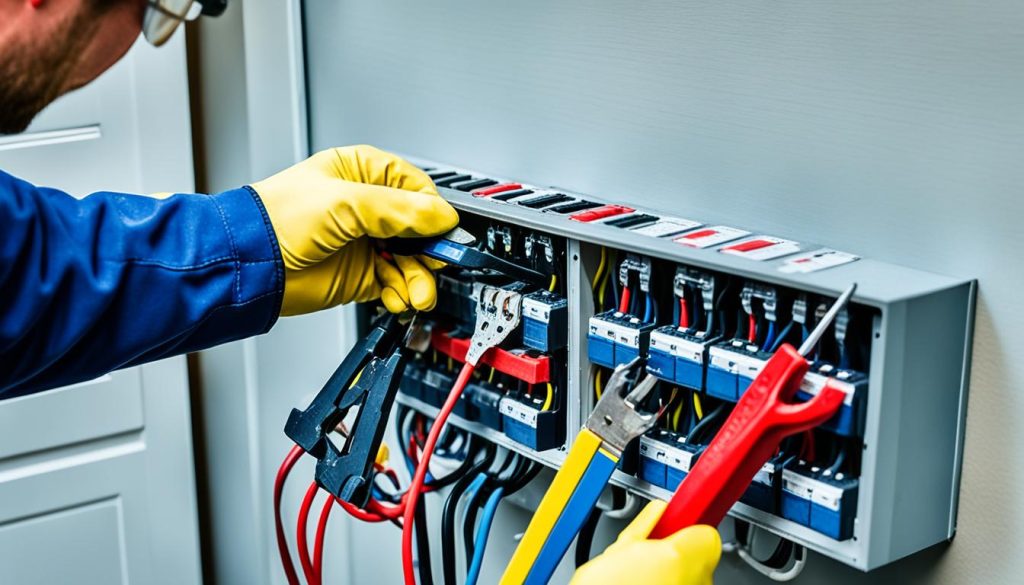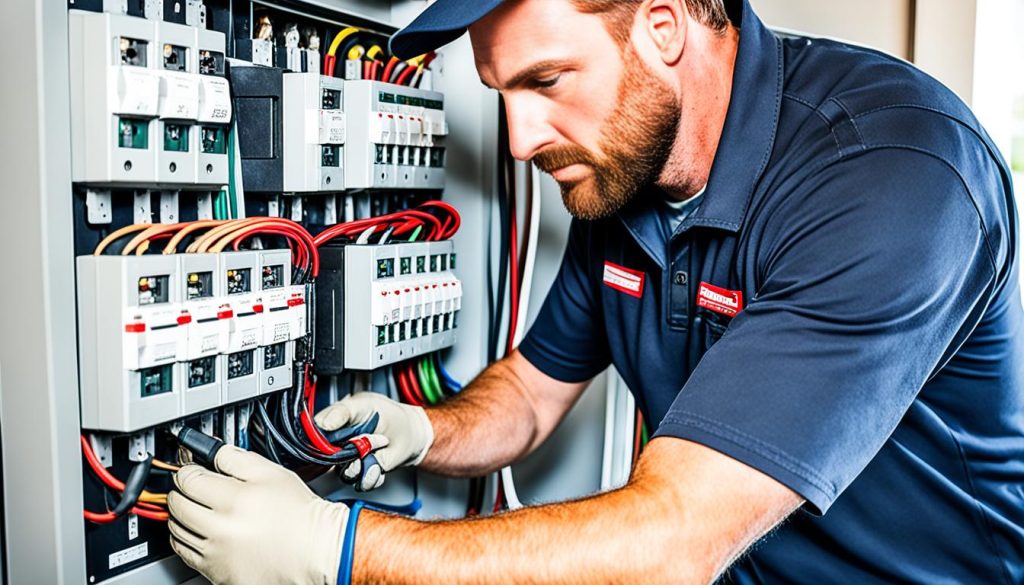Protecting your home from electrical surges is essential to ensure the safety and longevity of your electrical devices and appliances. Whether caused by lightning strikes, power line issues, or fluctuations in household appliances, these surges can cause significant damage if left unchecked. That’s why installing a whole-house surge protector is a smart investment for any homeowner.
Are you unsure how to install a whole house surge protector? Don’t worry! In this comprehensive guide, we will walk you through the step-by-step process of installing a surge protector for your entire house. By following our instructions, you can rest easy knowing that your electrical system is safeguarded against harmful surges.
Key Takeaways:
- Installing a whole-house surge protector protects your home from electrical surges caused by various factors.
- It is crucial to have the right tools and materials before starting the installation process.
- Step-by-step instructions will help you complete the installation successfully.
- Consider hiring a professional electrician for a safe and proper installation.
- A whole-house surge protector offers benefits such as protecting electronic devices, reducing the risk of fires, and increasing home resale value.
Tools and Materials Needed for Installation
Before you begin the surge protector installation process, it’s essential to gather all the necessary tools and materials. Having everything prepared will ensure a smooth and efficient installation. Here’s a list of the items you’ll need:
- Personal Protective Equipment: Insulated work boots, electrical safety gloves, and eye protection are vital to safeguard yourself during the installation.
- Non-Contact Voltage Tester: This tool helps you determine if the power is shut off before working on the electrical panel.
- Double-Pole Circuit Breaker: You’ll need a circuit breaker that matches the rating of your surge protector for proper installation.
- Cable Clamp: A cable clamp secures the surge protector to the electrical panel, providing stability.
- Screwdriver or Drill: Depending on the type of fasteners included with your surge protector, you’ll need either a screwdriver or a drill to secure it in place.
- Wire Strippers: Wire strippers are necessary to remove the insulation from the wires for proper connections.
- Hammer and Nail Punch: These tools may be required if you need to create holes in the panel or walls for cable routing.
Having these tools and materials ready will ensure a safe and efficient surge protector installation process, protecting your home from electrical surges and ensuring the longevity of your electronic devices.
| Tools | Materials |
|---|---|
| Screwdriver or Drill | Double-Pole Circuit Breaker |
| Wire Strippers | Cable Clamp |
| Hammer | Insulated Work Boots |
| Nail Punch | Electrical Safety Gloves |
| Eye Protection |
Step-by-Step Guide for Whole-House Surge Protector Installation
Protecting your home from electrical surges is essential to safeguard your valuable electronic devices and appliances. Follow these step-by-step instructions to install a whole-house surge protector and enjoy peace of mind knowing your electrical system is protected.
Step 1: Shut Off Power
Before starting the installation process, the first step is to shut off the power to your electrical panel. This ensures your safety while working with electricity. Locate the main circuit breaker in your panel and switch it off.
Step 2: Prep the Panel
Open the electrical panel door and carefully remove the cover. Use a non-contact voltage tester to double-check that the power is off. Ensure there is no live electricity running through the panel before proceeding further.
Step 3: Mount the Surge Protector
Choose a suitable location inside the panel to mount the surge protector. It should be easily accessible and away from any obstructions. Use the provided mounting brackets and screws to secure the surge protector in place.
Step 4: Connect the Wires
Connect the surge protector to the panel using the instructions provided by the manufacturer. Follow the color-coded wires and use wire strippers to remove the insulation from the ends. Connect the wires securely, ensuring a tight and reliable connection.
Step 5: Reassemble the Electrical Panel
Once the wires are connected, carefully reassemble the electrical panel cover. Ensure all screws are tightened properly to secure the panel in place. Make sure there are no loose wires or other obstructions that could interfere with the proper functioning of the surge protector.
Step 6: Restore Power
After confirming that the electrical panel is properly reassembled, you can restore power to your home. Gradually switch on each circuit breaker, making sure to check for any issues or malfunctions. Once all circuits are back on, the whole-house surge protector is ready to provide protection against electrical surges.
By following these step-by-step instructions for whole-house surge protector installation, you can ensure the safety of your electrical system and the longevity of your electronic devices and appliances.
| Installation Steps | Description |
|---|---|
| Step 1: Shut Off Power | Turn off the main circuit breaker to cut power to the electrical panel. |
| Step 2: Prep the Panel | Remove the panel cover and use a non-contact voltage tester to verify the power is off. |
| Step 3: Mount the Surge Protector | Select a suitable location and securely mount the surge protector using the provided brackets and screws. |
| Step 4: Connect the Wires | Follow the manufacturer’s instructions to connect the surge protector to the electrical panel. |
| Step 5: Reassemble the Electrical Panel | Carefully reassemble the panel cover, ensuring all screws are tightened properly. |
| Step 6: Restore Power | Gradually switch on each circuit breaker to restore power to your home. |
Installing a surge protector is a wise investment in protecting your home and electronic devices from damaging electrical surges. With the help of this step-by-step guide, you can easily install a whole-house surge protector and enjoy the benefits of enhanced electrical safety.

Hiring a Professional vs. DIY Installation
While it is possible for skilled homeowners to install a whole-house surge protector themselves, it is important to consider the risks involved in a DIY installation. Working in an electrical service panel can be dangerous and can lead to electrocution if proper precautions are not taken. Additionally, certain types of surge protectors may require specialized knowledge and expertise, making it advisable to hire a professional for installation.
When hiring an electrician for surge protector installation, you can benefit from their experience and expertise in handling electrical systems. A licensed electrician will ensure that the installation is done safely and correctly, following all electrical safety regulations and guidelines. By entrusting the job to a professional, you can have peace of mind knowing that your surge protector is installed properly, providing maximum protection for your home.
On the other hand, opting for a DIY installation carries certain risks. Without the proper knowledge and skills, you may unknowingly make mistakes that can result in improper wiring or inadequate protection. This can leave your electrical system vulnerable to surges, defeating the purpose of installing a surge protector in the first place.
Moreover, DIY installation increases the likelihood of accidents and harm to yourself and your electrical system. Mishandling electrical components can lead to electrical shocks or even fires, jeopardizing both your safety and the integrity of your home’s electrical infrastructure.
“It is always better to be safe than sorry. Hiring a professional electrician for surge protector installation is a smart investment in both your safety and the effectiveness of the surge protection.”
By hiring a professional, you can avoid the risks associated with DIY installation and ensure that your surge protector is installed correctly. This not only safeguards your home and valuable electronic devices but also upholds electrical safety standards that protect you and your loved ones.
| Hiring a Professional | DIY Installation |
|---|---|
| Ensures proper installation and maximum protection | Risks improper wiring and inadequate protection |
| Follows electrical safety regulations and guidelines | Increases the likelihood of accidents and electrical hazards |
| Utilizes expertise and experience | Relies on limited knowledge and skills |

Choosing to hire a professional for surge protector installation is a wise decision that prioritizes safety and ensures effective protection against electrical surges. Don’t compromise on the safety of your home and loved ones. Consult with a licensed electrician to ensure a professional surge protector installation.
Benefits of Whole-House Surge Protector Installation
Installing a whole-house surge protector offers numerous advantages for protecting your home and electrical devices. One of the key benefits is the comprehensive protection it provides against electrical surges, safeguarding all electronics and appliances in your home. With a surge protector in place, you can prevent damage to your valuable devices, such as televisions, computers, refrigerators, and more.
By avoiding damage to electronic devices, you not only save money on costly replacements but also reduce the risk of electrical fires. Electrical surges can cause malfunctions, overheating, or even short circuits that may lead to fires. With a whole-house surge protector, you can minimize these risks, ensuring the safety of your household and property.
Furthermore, installing a surge protector can increase the resale value of your home. Potential buyers recognize the importance of protecting their devices from electrical surges and view a surge protector as a significant asset. A home with a whole-house surge protector signals that the electrical system is safeguarded, providing peace of mind for future residents and increasing the overall appeal of your property.
In conclusion, investing in a whole-house surge protector brings multiple benefits. It shields your electronics from power surges, prevents damage and potential electrical fires, saves you money on replacements, and enhances the value of your home. By taking this proactive step, you can ensure the longevity and safety of your electrical system while enjoying the peace of mind that comes with comprehensive surge protection.
FAQ
Why is it important to install a whole-house surge protector?
Installing a whole-house surge protector is crucial to protect your home from electrical surges that can cause damage to your electrical devices and appliances.
What can cause electrical surges in a home?
Electrical surges can be caused by lightning strikes, downed power lines, increased demand from industrial plants, or temporary surges from household appliances.
Can I install a whole-house surge protector myself?
While it is possible for skilled homeowners to install a whole-house surge protector themselves, this task can pose serious risks if not done correctly. It is recommended to hire a licensed electrician for installation.
What are the benefits of installing a whole-house surge protector?
Installing a whole-house surge protector provides comprehensive protection against electrical surges for all electronics and appliances in your home. It can prevent damage to these devices, reduce the risk of electrical fires, and increase the resale value of your home.
What tools and materials do I need for whole-house surge protector installation?
You will need personal protective equipment such as insulated work boots, electrical safety gloves, and eye protection, as well as a non-contact voltage tester, double-pole circuit breaker rated for your surge protector, cable clamp, screwdriver or drill, wire strippers, hammer, and nail punch.
Should I hire a professional or attempt DIY installation?
Hiring a licensed electrician ensures the job is done safely and correctly, following all electrical safety regulations. DIY installation carries the risk of improper wiring, inadequate protection, and potential harm to yourself and your electrical system.


